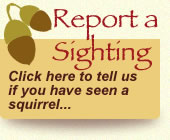Squirrelpox Surveillance Program
Squirrelpox Surveillance Program
If you are undertaking grey squirrel control but have not been in touch with RSSS please contact us and we will provide you with pox sampling kits and training for sample collection.
The Red Squirrels in South Scotland project (RSSS) is working to identify areas where Squirrelpox carrying grey squirrels occur as these areas run a high risk of having a Squirrelpox virus outbreak amongst red squirrels. To do this we need to take blood samples from grey squirrels. Where seropositive (pox carrying) grey squirrels are found the project will aim to increase the trapping effort in that area to try and reduce the likelihood of the disease spreading to the red squirrel population.
 Grey squirrels controlled by the full time grey squirrel control officers are regularly tested for the pox virus. Different levels of testing are undertaken depending on whether the area has or has not been identified as already having a high prevalence of the virus. The large majority of grey squirrels controlled outside of the known distribution of the pox virus are sampled. Most of the people involved in the RSSS Trap Loan Scheme participate in the Squirrelpox Surveillance Program by regularly sending in blood samples from the grey squirrels that they control. All trap loan participants are provided with pox sampling kits and trained in the collection of samples. All blood samples are tested by the Moredun International Virus Surveillance Unit near Edinburgh.
Grey squirrels controlled by the full time grey squirrel control officers are regularly tested for the pox virus. Different levels of testing are undertaken depending on whether the area has or has not been identified as already having a high prevalence of the virus. The large majority of grey squirrels controlled outside of the known distribution of the pox virus are sampled. Most of the people involved in the RSSS Trap Loan Scheme participate in the Squirrelpox Surveillance Program by regularly sending in blood samples from the grey squirrels that they control. All trap loan participants are provided with pox sampling kits and trained in the collection of samples. All blood samples are tested by the Moredun International Virus Surveillance Unit near Edinburgh.
The public are encouraged to report sick red squirrels and send dead red squirrels for Post Mortem examination. The Royal (Dick) School of Veterinary Studies ascertains the cause of death and blood samples from any possible pox victims are sent to the Mordun with tissue samples sent to the Veterinary Laboratory Agency (VLA) in order to confirm the presence or absence of the Squirrelpox virus. The VLA uses transmission electron microscopy (TEM) to identify and photograph the virus particles present in the infected tissue.


Squirrelpox virus particles as seen under transmission electron microscopy (bar = 200nm)
photos provided by D. Everest of the Veterinary Laboratory Agency
Click here for a printable version (pdf)

Please note this link will open a new window which will take you to the Scottish Wildlife Trust website where you can record your squirrel sightings.
Website by
Stewartry Technology





